| // Copyright 2013 The Flutter Authors. All rights reserved. |
| // Use of this source code is governed by a BSD-style license that can be |
| // found in the LICENSE file. |
| |
| // @dart = 2.6 |
| part of ui; |
| |
| // ignore: unused_element, Used in Shader assert. |
| bool _offsetIsValid(Offset offset) { |
| assert(offset != null, 'Offset argument was null.'); |
| assert(!offset.dx.isNaN && !offset.dy.isNaN, |
| 'Offset argument contained a NaN value.'); |
| return true; |
| } |
| |
| // ignore: unused_element, Used in Shader assert. |
| bool _matrix4IsValid(Float32List matrix4) { |
| assert(matrix4 != null, 'Matrix4 argument was null.'); |
| assert(matrix4.length == 16, 'Matrix4 must have 16 entries.'); |
| return true; |
| } |
| |
| void _validateColorStops(List<Color> colors, List<double> colorStops) { |
| if (colorStops == null) { |
| if (colors.length != 2) |
| throw ArgumentError( |
| '"colors" must have length 2 if "colorStops" is omitted.'); |
| } else { |
| if (colors.length != colorStops.length) |
| throw ArgumentError( |
| '"colors" and "colorStops" arguments must have equal length.'); |
| } |
| } |
| |
| Color _scaleAlpha(Color a, double factor) { |
| return a.withAlpha((a.alpha * factor).round().clamp(0, 255)); |
| } |
| |
| /// An immutable 32 bit color value in ARGB |
| class Color { |
| /// Construct a color from the lower 32 bits of an int. |
| /// |
| /// Bits 24-31 are the alpha value. |
| /// Bits 16-23 are the red value. |
| /// Bits 8-15 are the green value. |
| /// Bits 0-7 are the blue value. |
| const Color(int value) : this.value = value & 0xFFFFFFFF; |
| |
| /// Construct a color from the lower 8 bits of four integers. |
| const Color.fromARGB(int a, int r, int g, int b) |
| : value = (((a & 0xff) << 24) | |
| ((r & 0xff) << 16) | |
| ((g & 0xff) << 8) | |
| ((b & 0xff) << 0)) & |
| 0xFFFFFFFF; |
| |
| /// Create a color from red, green, blue, and opacity, similar to `rgba()` in CSS. |
| /// |
| /// * `r` is [red], from 0 to 255. |
| /// * `g` is [green], from 0 to 255. |
| /// * `b` is [blue], from 0 to 255. |
| /// * `opacity` is alpha channel of this color as a double, with 0.0 being |
| /// transparent and 1.0 being fully opaque. |
| /// |
| /// Out of range values are brought into range using modulo 255. |
| /// |
| /// See also [fromARGB], which takes the opacity as an integer value. |
| const Color.fromRGBO(int r, int g, int b, double opacity) |
| : value = ((((opacity * 0xff ~/ 1) & 0xff) << 24) | |
| ((r & 0xff) << 16) | |
| ((g & 0xff) << 8) | |
| ((b & 0xff) << 0)) & |
| 0xFFFFFFFF; |
| |
| /// A 32 bit value representing this color. |
| /// |
| /// Bits 24-31 are the alpha value. |
| /// Bits 16-23 are the red value. |
| /// Bits 8-15 are the green value. |
| /// Bits 0-7 are the blue value. |
| final int value; |
| |
| /// The alpha channel of this color in an 8 bit value. |
| int get alpha => (0xff000000 & value) >> 24; |
| |
| /// The alpha channel of this color as a double. |
| double get opacity => alpha / 0xFF; |
| |
| /// The red channel of this color in an 8 bit value. |
| int get red => (0x00ff0000 & value) >> 16; |
| |
| /// The green channel of this color in an 8 bit value. |
| int get green => (0x0000ff00 & value) >> 8; |
| |
| /// The blue channel of this color in an 8 bit value. |
| int get blue => (0x000000ff & value) >> 0; |
| |
| /// Returns a new color that matches this color with the alpha channel |
| /// replaced with a (which ranges from 0 to 255). |
| Color withAlpha(int a) { |
| return Color.fromARGB(a, red, green, blue); |
| } |
| |
| /// Returns a new color that matches this color with the alpha channel |
| /// replaced with the given opacity (which ranges from 0.0 to 1.0). |
| Color withOpacity(double opacity) { |
| assert(opacity >= 0.0 && opacity <= 1.0); |
| return withAlpha((255.0 * opacity).round()); |
| } |
| |
| /// Returns a new color that matches this color with the red channel replaced |
| /// with r. |
| Color withRed(int r) { |
| return Color.fromARGB(alpha, r, green, blue); |
| } |
| |
| /// Returns a new color that matches this color with the green channel |
| /// replaced with g. |
| Color withGreen(int g) { |
| return Color.fromARGB(alpha, red, g, blue); |
| } |
| |
| /// Returns a new color that matches this color with the blue channel replaced |
| /// with b. |
| Color withBlue(int b) { |
| return Color.fromARGB(alpha, red, green, b); |
| } |
| |
| // See <https://www.w3.org/TR/WCAG20/#relativeluminancedef> |
| static double _linearizeColorComponent(double component) { |
| if (component <= 0.03928) { |
| return component / 12.92; |
| } |
| return math.pow((component + 0.055) / 1.055, 2.4); |
| } |
| |
| /// Returns a brightness value between 0 for darkest and 1 for lightest. |
| /// |
| /// Represents the relative luminance of the color. This value is |
| /// computationally expensive to calculate. |
| /// |
| /// See <https://en.wikipedia.org/wiki/Relative_luminance>. |
| double computeLuminance() { |
| // See <https://www.w3.org/TR/WCAG20/#relativeluminancedef> |
| final double R = _linearizeColorComponent(red / 0xFF); |
| final double G = _linearizeColorComponent(green / 0xFF); |
| final double B = _linearizeColorComponent(blue / 0xFF); |
| return 0.2126 * R + 0.7152 * G + 0.0722 * B; |
| } |
| |
| /// Linearly interpolate between two colors. |
| /// |
| /// This is intended to be fast but as a result may be ugly. Consider |
| /// [HSVColor] or writing custom logic for interpolating colors. |
| /// |
| /// If either color is null, this function linearly interpolates from a |
| /// transparent instance of the other color. This is usually preferable to |
| /// interpolating from [material.Colors.transparent] (`const |
| /// Color(0x00000000)`), which is specifically transparent _black_. |
| /// |
| /// The `t` argument represents position on the timeline, with 0.0 meaning |
| /// that the interpolation has not started, returning `a` (or something |
| /// equivalent to `a`), 1.0 meaning that the interpolation has finished, |
| /// returning `b` (or something equivalent to `b`), and values in between |
| /// meaning that the interpolation is at the relevant point on the timeline |
| /// between `a` and `b`. The interpolation can be extrapolated beyond 0.0 and |
| /// 1.0, so negative values and values greater than 1.0 are valid (and can |
| /// easily be generated by curves such as [Curves.elasticInOut]). Each channel |
| /// will be clamped to the range 0 to 255. |
| /// |
| /// Values for `t` are usually obtained from an [Animation<double>], such as |
| /// an [AnimationController]. |
| static Color lerp(Color a, Color b, double t) { |
| assert(t != null); |
| if (a == null && b == null) { |
| return null; |
| } |
| if (a == null) { |
| return _scaleAlpha(b, t); |
| } |
| if (b == null) { |
| return _scaleAlpha(a, 1.0 - t); |
| } |
| return Color.fromARGB( |
| lerpDouble(a.alpha, b.alpha, t).toInt().clamp(0, 255), |
| lerpDouble(a.red, b.red, t).toInt().clamp(0, 255), |
| lerpDouble(a.green, b.green, t).toInt().clamp(0, 255), |
| lerpDouble(a.blue, b.blue, t).toInt().clamp(0, 255), |
| ); |
| } |
| |
| /// Combine the foreground color as a transparent color over top |
| /// of a background color, and return the resulting combined color. |
| /// |
| /// This uses standard alpha blending ("SRC over DST") rules to produce a |
| /// blended color from two colors. This can be used as a performance |
| /// enhancement when trying to avoid needless alpha blending compositing |
| /// operations for two things that are solid colors with the same shape, but |
| /// overlay each other: instead, just paint one with the combined color. |
| static Color alphaBlend(Color foreground, Color background) { |
| final int alpha = foreground.alpha; |
| if (alpha == 0x00) { |
| // Foreground completely transparent. |
| return background; |
| } |
| final int invAlpha = 0xff - alpha; |
| int backAlpha = background.alpha; |
| if (backAlpha == 0xff) { |
| // Opaque background case |
| return Color.fromARGB( |
| 0xff, |
| (alpha * foreground.red + invAlpha * background.red) ~/ 0xff, |
| (alpha * foreground.green + invAlpha * background.green) ~/ 0xff, |
| (alpha * foreground.blue + invAlpha * background.blue) ~/ 0xff, |
| ); |
| } else { |
| // General case |
| backAlpha = (backAlpha * invAlpha) ~/ 0xff; |
| final int outAlpha = alpha + backAlpha; |
| assert(outAlpha != 0x00); |
| return Color.fromARGB( |
| outAlpha, |
| (foreground.red * alpha + background.red * backAlpha) ~/ outAlpha, |
| (foreground.green * alpha + background.green * backAlpha) ~/ outAlpha, |
| (foreground.blue * alpha + background.blue * backAlpha) ~/ outAlpha, |
| ); |
| } |
| } |
| |
| /// Returns an alpha value representative of the provided [opacity] value. |
| /// |
| /// The [opacity] value may not be null. |
| static int getAlphaFromOpacity(double opacity) { |
| assert(opacity != null); |
| return (opacity.clamp(0.0, 1.0) * 255).round(); |
| } |
| |
| @override |
| bool operator ==(dynamic other) { |
| if (identical(this, other)) { |
| return true; |
| } |
| if (other.runtimeType != runtimeType) { |
| return false; |
| } |
| final Color typedOther = other; |
| return value == typedOther.value; |
| } |
| |
| @override |
| int get hashCode => value.hashCode; |
| |
| @override |
| String toString() { |
| return 'Color(0x${value.toRadixString(16).padLeft(8, '0')})'; |
| } |
| } |
| |
| /// Styles to use for line endings. |
| /// |
| /// See [Paint.strokeCap]. |
| enum StrokeCap { |
| /// Begin and end contours with a flat edge and no extension. |
| butt, |
| |
| /// Begin and end contours with a semi-circle extension. |
| round, |
| |
| /// Begin and end contours with a half square extension. This is |
| /// similar to extending each contour by half the stroke width (as |
| /// given by [Paint.strokeWidth]). |
| square, |
| } |
| |
| /// Styles to use for line segment joins. |
| /// |
| /// This only affects line joins for polygons drawn by [Canvas.drawPath] and |
| /// rectangles, not points drawn as lines with [Canvas.drawPoints]. |
| /// |
| /// See also: |
| /// |
| /// * [Paint.strokeJoin] and [Paint.strokeMiterLimit] for how this value is |
| /// used. |
| /// * [StrokeCap] for the different kinds of line endings. |
| // These enum values must be kept in sync with SkPaint::Join. |
| enum StrokeJoin { |
| /// Joins between line segments form sharp corners. |
| /// |
| /// {@animation 300 300 https://flutter.github.io/assets-for-api-docs/assets/dart-ui/miter_4_join.mp4} |
| /// |
| /// The center of the line segment is colored in the diagram above to |
| /// highlight the join, but in normal usage the join is the same color as the |
| /// line. |
| /// |
| /// See also: |
| /// |
| /// * [Paint.strokeJoin], used to set the line segment join style to this |
| /// value. |
| /// * [Paint.strokeMiterLimit], used to define when a miter is drawn instead |
| /// of a bevel when the join is set to this value. |
| miter, |
| |
| /// Joins between line segments are semi-circular. |
| /// |
| /// {@animation 300 300 https://flutter.github.io/assets-for-api-docs/assets/dart-ui/round_join.mp4} |
| /// |
| /// The center of the line segment is colored in the diagram above to |
| /// highlight the join, but in normal usage the join is the same color as the |
| /// line. |
| /// |
| /// See also: |
| /// |
| /// * [Paint.strokeJoin], used to set the line segment join style to this |
| /// value. |
| round, |
| |
| /// Joins between line segments connect the corners of the butt ends of the |
| /// line segments to give a beveled appearance. |
| /// |
| /// {@animation 300 300 https://flutter.github.io/assets-for-api-docs/assets/dart-ui/bevel_join.mp4} |
| /// |
| /// The center of the line segment is colored in the diagram above to |
| /// highlight the join, but in normal usage the join is the same color as the |
| /// line. |
| /// |
| /// See also: |
| /// |
| /// * [Paint.strokeJoin], used to set the line segment join style to this |
| /// value. |
| bevel, |
| } |
| |
| /// Strategies for painting shapes and paths on a canvas. |
| /// |
| /// See [Paint.style]. |
| enum PaintingStyle { |
| /// Apply the [Paint] to the inside of the shape. For example, when |
| /// applied to the [Paint.drawCircle] call, this results in a disc |
| /// of the given size being painted. |
| fill, |
| |
| /// Apply the [Paint] to the edge of the shape. For example, when |
| /// applied to the [Paint.drawCircle] call, this results is a hoop |
| /// of the given size being painted. The line drawn on the edge will |
| /// be the width given by the [Paint.strokeWidth] property. |
| stroke, |
| } |
| |
| /// Algorithms to use when painting on the canvas. |
| /// |
| /// When drawing a shape or image onto a canvas, different algorithms can be |
| /// used to blend the pixels. The different values of [BlendMode] specify |
| /// different such algorithms. |
| /// |
| /// Each algorithm has two inputs, the _source_, which is the image being drawn, |
| /// and the _destination_, which is the image into which the source image is |
| /// being composited. The destination is often thought of as the _background_. |
| /// The source and destination both have four color channels, the red, green, |
| /// blue, and alpha channels. These are typically represented as numbers in the |
| /// range 0.0 to 1.0. The output of the algorithm also has these same four |
| /// channels, with values computed from the source and destination. |
| /// |
| /// The documentation of each value below describes how the algorithm works. In |
| /// each case, an image shows the output of blending a source image with a |
| /// destination image. In the images below, the destination is represented by an |
| /// image with horizontal lines and an opaque landscape photograph, and the |
| /// source is represented by an image with vertical lines (the same lines but |
| /// rotated) and a bird clip-art image. The [src] mode shows only the source |
| /// image, and the [dst] mode shows only the destination image. In the |
| /// documentation below, the transparency is illustrated by a checkerboard |
| /// pattern. The [clear] mode drops both the source and destination, resulting |
| /// in an output that is entirely transparent (illustrated by a solid |
| /// checkerboard pattern). |
| /// |
| /// The horizontal and vertical bars in these images show the red, green, and |
| /// blue channels with varying opacity levels, then all three color channels |
| /// together with those same varying opacity levels, then all three color |
| /// channels set to zero with those varying opacity levels, then two bars |
| /// showing a red/green/blue repeating gradient, the first with full opacity and |
| /// the second with partial opacity, and finally a bar with the three color |
| /// channels set to zero but the opacity varying in a repeating gradient. |
| /// |
| /// ## Application to the [Canvas] API |
| /// |
| /// When using [Canvas.saveLayer] and [Canvas.restore], the blend mode of the |
| /// [Paint] given to the [Canvas.saveLayer] will be applied when |
| /// [Canvas.restore] is called. Each call to [Canvas.saveLayer] introduces a new |
| /// layer onto which shapes and images are painted; when [Canvas.restore] is |
| /// called, that layer is then composited onto the parent layer, with the source |
| /// being the most-recently-drawn shapes and images, and the destination being |
| /// the parent layer. (For the first [Canvas.saveLayer] call, the parent layer |
| /// is the canvas itself.) |
| /// |
| /// See also: |
| /// |
| /// * [Paint.blendMode], which uses [BlendMode] to define the compositing |
| /// strategy. |
| enum BlendMode { |
| // This list comes from Skia's SkXfermode.h and the values (order) should be |
| // kept in sync. |
| // See: https://skia.org/user/api/skpaint#SkXfermode |
| |
| /// Drop both the source and destination images, leaving nothing. |
| /// |
| /// This corresponds to the "clear" Porter-Duff operator. |
| /// |
| /// 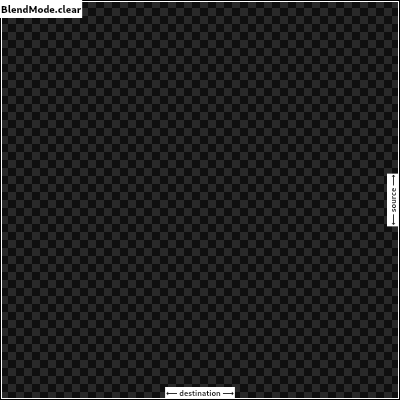 |
| clear, |
| |
| /// Drop the destination image, only paint the source image. |
| /// |
| /// Conceptually, the destination is first cleared, then the source image is |
| /// painted. |
| /// |
| /// This corresponds to the "Copy" Porter-Duff operator. |
| /// |
| /// 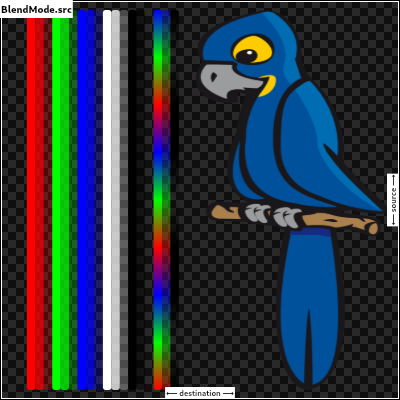 |
| src, |
| |
| /// Drop the source image, only paint the destination image. |
| /// |
| /// Conceptually, the source image is discarded, leaving the destination |
| /// untouched. |
| /// |
| /// This corresponds to the "Destination" Porter-Duff operator. |
| /// |
| /// 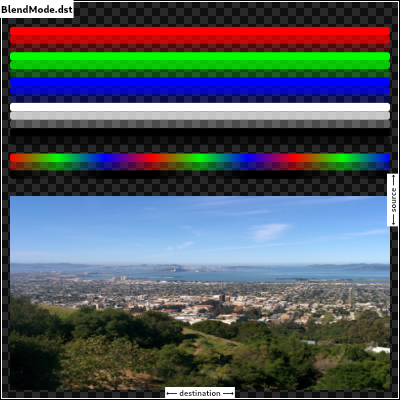 |
| dst, |
| |
| /// Composite the source image over the destination image. |
| /// |
| /// This is the default value. It represents the most intuitive case, where |
| /// shapes are painted on top of what is below, with transparent areas showing |
| /// the destination layer. |
| /// |
| /// This corresponds to the "Source over Destination" Porter-Duff operator, |
| /// also known as the Painter's Algorithm. |
| /// |
| ///  |
| srcOver, |
| |
| /// Composite the source image under the destination image. |
| /// |
| /// This is the opposite of [srcOver]. |
| /// |
| /// This corresponds to the "Destination over Source" Porter-Duff operator. |
| /// |
| /// 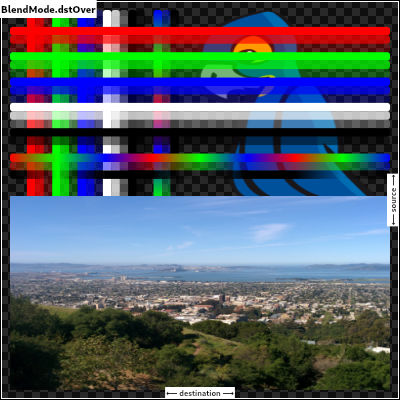 |
| /// |
| /// This is useful when the source image should have been painted before the |
| /// destination image, but could not be. |
| dstOver, |
| |
| /// Show the source image, but only where the two images overlap. The |
| /// destination image is not rendered, it is treated merely as a mask. The |
| /// color channels of the destination are ignored, only the opacity has an |
| /// effect. |
| /// |
| /// To show the destination image instead, consider [dstIn]. |
| /// |
| /// To reverse the semantic of the mask (only showing the source where the |
| /// destination is absent, rather than where it is present), consider |
| /// [srcOut]. |
| /// |
| /// This corresponds to the "Source in Destination" Porter-Duff operator. |
| /// |
| /// 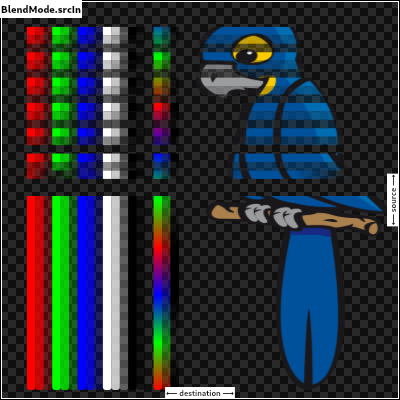 |
| srcIn, |
| |
| /// Show the destination image, but only where the two images overlap. The |
| /// source image is not rendered, it is treated merely as a mask. The color |
| /// channels of the source are ignored, only the opacity has an effect. |
| /// |
| /// To show the source image instead, consider [srcIn]. |
| /// |
| /// To reverse the semantic of the mask (only showing the source where the |
| /// destination is present, rather than where it is absent), consider |
| /// [dstOut]. |
| /// |
| /// This corresponds to the "Destination in Source" Porter-Duff operator. |
| /// |
| /// 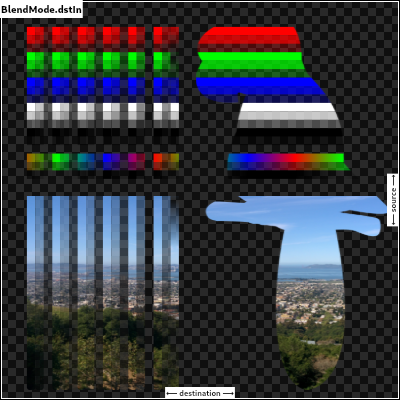 |
| dstIn, |
| |
| /// Show the source image, but only where the two images do not overlap. The |
| /// destination image is not rendered, it is treated merely as a mask. The color |
| /// channels of the destination are ignored, only the opacity has an effect. |
| /// |
| /// To show the destination image instead, consider [dstOut]. |
| /// |
| /// To reverse the semantic of the mask (only showing the source where the |
| /// destination is present, rather than where it is absent), consider [srcIn]. |
| /// |
| /// This corresponds to the "Source out Destination" Porter-Duff operator. |
| /// |
| ///  |
| srcOut, |
| |
| /// Show the destination image, but only where the two images do not overlap. |
| /// The source image is not rendered, it is treated merely as a mask. The |
| /// color channels of the source are ignored, only the opacity has an effect. |
| /// |
| /// To show the source image instead, consider [srcOut]. |
| /// |
| /// To reverse the semantic of the mask (only showing the destination where |
| /// the source is present, rather than where it is absent), consider [dstIn]. |
| /// |
| /// This corresponds to the "Destination out Source" Porter-Duff operator. |
| /// |
| /// 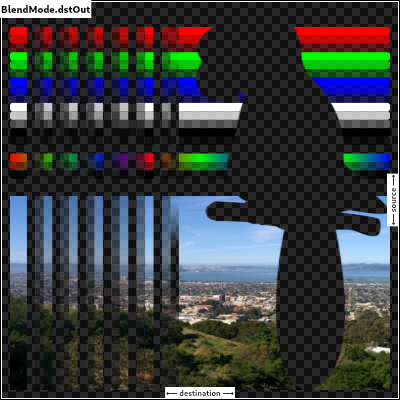 |
| dstOut, |
| |
| /// Composite the source image over the destination image, but only where it |
| /// overlaps the destination. |
| /// |
| /// This corresponds to the "Source atop Destination" Porter-Duff operator. |
| /// |
| /// This is essentially the [srcOver] operator, but with the output's opacity |
| /// channel being set to that of the destination image instead of being a |
| /// combination of both image's opacity channels. |
| /// |
| /// For a variant with the destination on top instead of the source, see |
| /// [dstATop]. |
| /// |
| /// 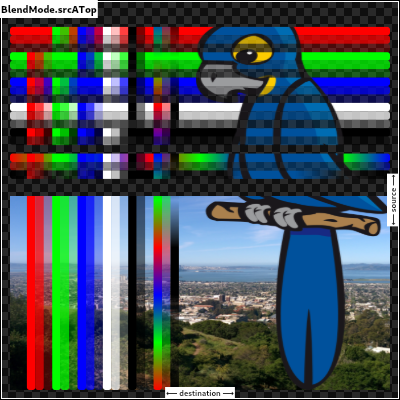 |
| srcATop, |
| |
| /// Composite the destination image over the source image, but only where it |
| /// overlaps the source. |
| /// |
| /// This corresponds to the "Destination atop Source" Porter-Duff operator. |
| /// |
| /// This is essentially the [dstOver] operator, but with the output's opacity |
| /// channel being set to that of the source image instead of being a |
| /// combination of both image's opacity channels. |
| /// |
| /// For a variant with the source on top instead of the destination, see |
| /// [srcATop]. |
| /// |
| /// 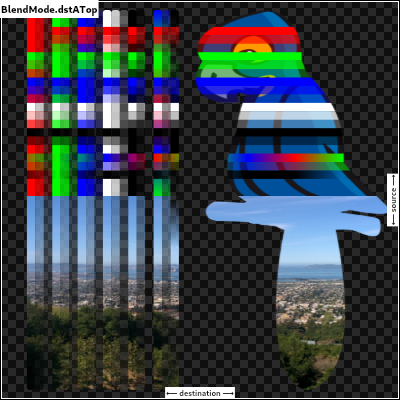 |
| dstATop, |
| |
| /// Apply a bitwise `xor` operator to the source and destination images. This |
| /// leaves transparency where they would overlap. |
| /// |
| /// This corresponds to the "Source xor Destination" Porter-Duff operator. |
| /// |
| /// 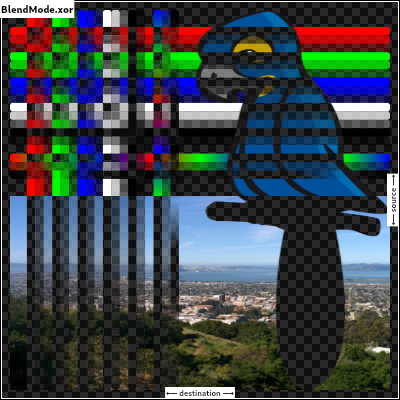 |
| xor, |
| |
| /// Sum the components of the source and destination images. |
| /// |
| /// Transparency in a pixel of one of the images reduces the contribution of |
| /// that image to the corresponding output pixel, as if the color of that |
| /// pixel in that image was darker. |
| /// |
| /// This corresponds to the "Source plus Destination" Porter-Duff operator. |
| /// |
| /// 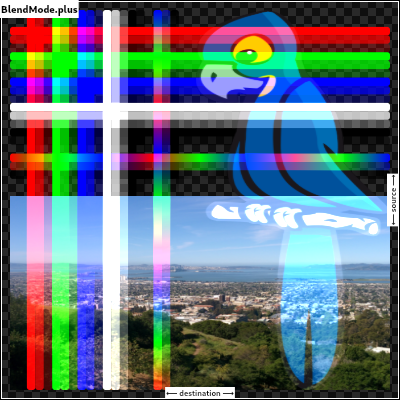 |
| plus, |
| |
| /// Multiply the color components of the source and destination images. |
| /// |
| /// This can only result in the same or darker colors (multiplying by white, |
| /// 1.0, results in no change; multiplying by black, 0.0, results in black). |
| /// |
| /// When compositing two opaque images, this has similar effect to overlapping |
| /// two transparencies on a projector. |
| /// |
| /// For a variant that also multiplies the alpha channel, consider [multiply]. |
| /// |
| /// 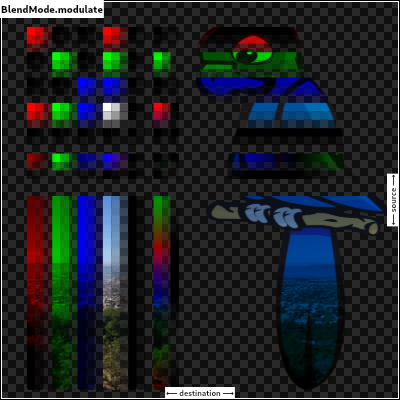 |
| /// |
| /// See also: |
| /// |
| /// * [screen], which does a similar computation but inverted. |
| /// * [overlay], which combines [modulate] and [screen] to favor the |
| /// destination image. |
| /// * [hardLight], which combines [modulate] and [screen] to favor the |
| /// source image. |
| modulate, |
| |
| // Following blend modes are defined in the CSS Compositing standard. |
| |
| /// Multiply the inverse of the components of the source and destination |
| /// images, and inverse the result. |
| /// |
| /// Inverting the components means that a fully saturated channel (opaque |
| /// white) is treated as the value 0.0, and values normally treated as 0.0 |
| /// (black, transparent) are treated as 1.0. |
| /// |
| /// This is essentially the same as [modulate] blend mode, but with the values |
| /// of the colors inverted before the multiplication and the result being |
| /// inverted back before rendering. |
| /// |
| /// This can only result in the same or lighter colors (multiplying by black, |
| /// 1.0, results in no change; multiplying by white, 0.0, results in white). |
| /// Similarly, in the alpha channel, it can only result in more opaque colors. |
| /// |
| /// This has similar effect to two projectors displaying their images on the |
| /// same screen simultaneously. |
| /// |
| ///  |
| /// |
| /// See also: |
| /// |
| /// * [modulate], which does a similar computation but without inverting the |
| /// values. |
| /// * [overlay], which combines [modulate] and [screen] to favor the |
| /// destination image. |
| /// * [hardLight], which combines [modulate] and [screen] to favor the |
| /// source image. |
| screen, // The last coeff mode. |
| |
| /// Multiply the components of the source and destination images after |
| /// adjusting them to favor the destination. |
| /// |
| /// Specifically, if the destination value is smaller, this multiplies it with |
| /// the source value, whereas is the source value is smaller, it multiplies |
| /// the inverse of the source value with the inverse of the destination value, |
| /// then inverts the result. |
| /// |
| /// Inverting the components means that a fully saturated channel (opaque |
| /// white) is treated as the value 0.0, and values normally treated as 0.0 |
| /// (black, transparent) are treated as 1.0. |
| /// |
| /// 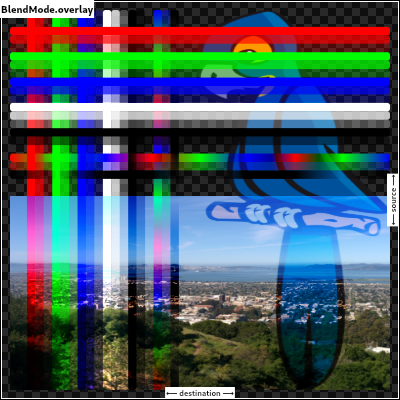 |
| /// |
| /// See also: |
| /// |
| /// * [modulate], which always multiplies the values. |
| /// * [screen], which always multiplies the inverses of the values. |
| /// * [hardLight], which is similar to [overlay] but favors the source image |
| /// instead of the destination image. |
| overlay, |
| |
| /// Composite the source and destination image by choosing the lowest value |
| /// from each color channel. |
| /// |
| /// The opacity of the output image is computed in the same way as for |
| /// [srcOver]. |
| /// |
| /// 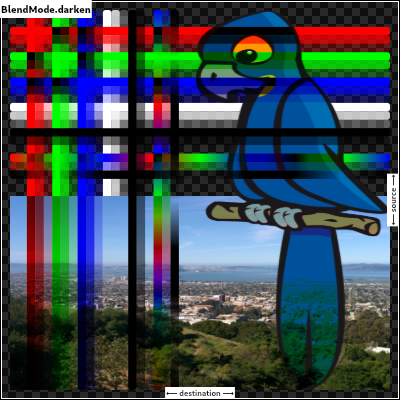 |
| darken, |
| |
| /// Composite the source and destination image by choosing the highest value |
| /// from each color channel. |
| /// |
| /// The opacity of the output image is computed in the same way as for |
| /// [srcOver]. |
| /// |
| /// 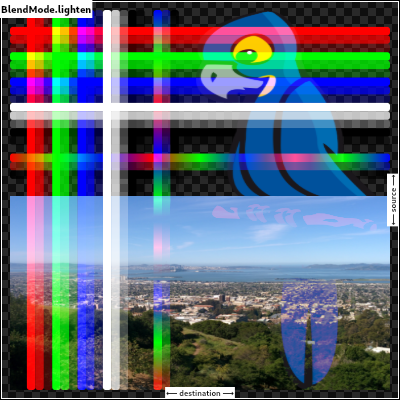 |
| lighten, |
| |
| /// Divide the destination by the inverse of the source. |
| /// |
| /// Inverting the components means that a fully saturated channel (opaque |
| /// white) is treated as the value 0.0, and values normally treated as 0.0 |
| /// (black, transparent) are treated as 1.0. |
| /// |
| /// 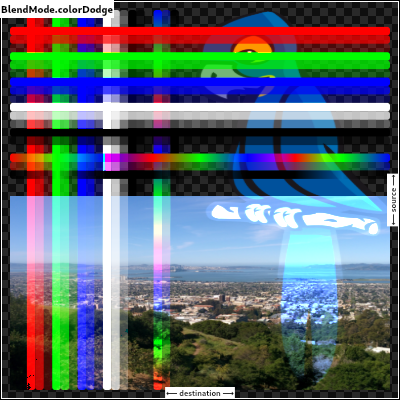 |
| colorDodge, |
| |
| /// Divide the inverse of the destination by the source, and inverse the result. |
| /// |
| /// Inverting the components means that a fully saturated channel (opaque |
| /// white) is treated as the value 0.0, and values normally treated as 0.0 |
| /// (black, transparent) are treated as 1.0. |
| /// |
| /// 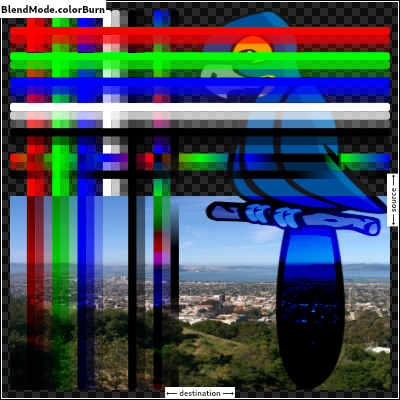 |
| colorBurn, |
| |
| /// Multiply the components of the source and destination images after |
| /// adjusting them to favor the source. |
| /// |
| /// Specifically, if the source value is smaller, this multiplies it with the |
| /// destination value, whereas is the destination value is smaller, it |
| /// multiplies the inverse of the destination value with the inverse of the |
| /// source value, then inverts the result. |
| /// |
| /// Inverting the components means that a fully saturated channel (opaque |
| /// white) is treated as the value 0.0, and values normally treated as 0.0 |
| /// (black, transparent) are treated as 1.0. |
| /// |
| /// 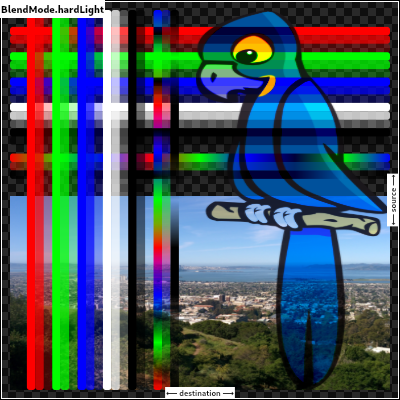 |
| /// |
| /// See also: |
| /// |
| /// * [modulate], which always multiplies the values. |
| /// * [screen], which always multiplies the inverses of the values. |
| /// * [overlay], which is similar to [hardLight] but favors the destination |
| /// image instead of the source image. |
| hardLight, |
| |
| /// Use [colorDodge] for source values below 0.5 and [colorBurn] for source |
| /// values above 0.5. |
| /// |
| /// This results in a similar but softer effect than [overlay]. |
| /// |
| /// 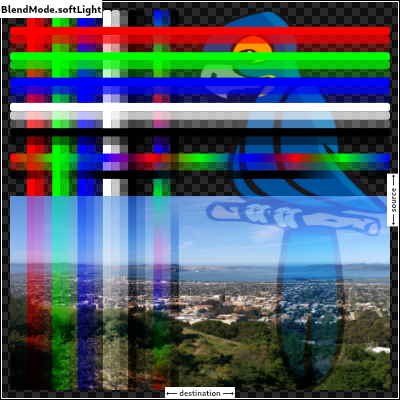 |
| /// |
| /// See also: |
| /// |
| /// * [color], which is a more subtle tinting effect. |
| softLight, |
| |
| /// Subtract the smaller value from the bigger value for each channel. |
| /// |
| /// Compositing black has no effect; compositing white inverts the colors of |
| /// the other image. |
| /// |
| /// The opacity of the output image is computed in the same way as for |
| /// [srcOver]. |
| /// |
| /// The effect is similar to [exclusion] but harsher. |
| /// |
| /// 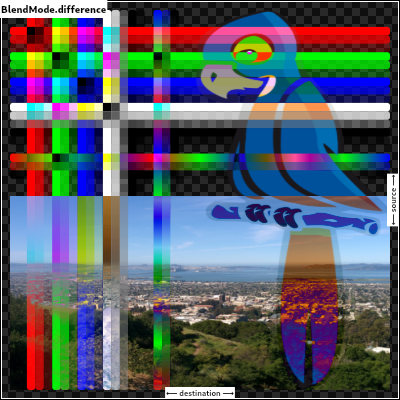 |
| difference, |
| |
| /// Subtract double the product of the two images from the sum of the two |
| /// images. |
| /// |
| /// Compositing black has no effect; compositing white inverts the colors of |
| /// the other image. |
| /// |
| /// The opacity of the output image is computed in the same way as for |
| /// [srcOver]. |
| /// |
| /// The effect is similar to [difference] but softer. |
| /// |
| /// 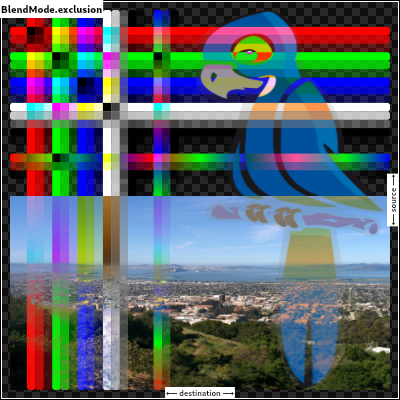 |
| exclusion, |
| |
| /// Multiply the components of the source and destination images, including |
| /// the alpha channel. |
| /// |
| /// This can only result in the same or darker colors (multiplying by white, |
| /// 1.0, results in no change; multiplying by black, 0.0, results in black). |
| /// |
| /// Since the alpha channel is also multiplied, a fully-transparent pixel |
| /// (opacity 0.0) in one image results in a fully transparent pixel in the |
| /// output. This is similar to [dstIn], but with the colors combined. |
| /// |
| /// For a variant that multiplies the colors but does not multiply the alpha |
| /// channel, consider [modulate]. |
| /// |
| /// 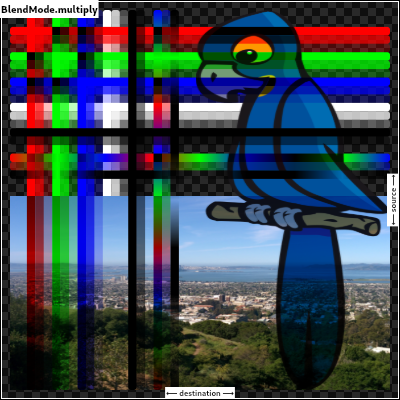 |
| multiply, // The last separable mode. |
| |
| /// Take the hue of the source image, and the saturation and luminosity of the |
| /// destination image. |
| /// |
| /// The effect is to tint the destination image with the source image. |
| /// |
| /// The opacity of the output image is computed in the same way as for |
| /// [srcOver]. Regions that are entirely transparent in the source image take |
| /// their hue from the destination. |
| /// |
| /// 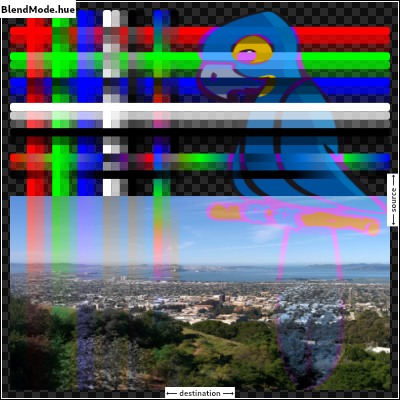 |
| /// |
| /// See also: |
| /// |
| /// * [color], which is a similar but stronger effect as it also applies the |
| /// saturation of the source image. |
| /// * [HSVColor], which allows colors to be expressed using Hue rather than |
| /// the red/green/blue channels of [Color]. |
| hue, |
| |
| /// Take the saturation of the source image, and the hue and luminosity of the |
| /// destination image. |
| /// |
| /// The opacity of the output image is computed in the same way as for |
| /// [srcOver]. Regions that are entirely transparent in the source image take |
| /// their saturation from the destination. |
| /// |
| ///  |
| /// |
| /// See also: |
| /// |
| /// * [color], which also applies the hue of the source image. |
| /// * [luminosity], which applies the luminosity of the source image to the |
| /// destination. |
| saturation, |
| |
| /// Take the hue and saturation of the source image, and the luminosity of the |
| /// destination image. |
| /// |
| /// The effect is to tint the destination image with the source image. |
| /// |
| /// The opacity of the output image is computed in the same way as for |
| /// [srcOver]. Regions that are entirely transparent in the source image take |
| /// their hue and saturation from the destination. |
| /// |
| /// 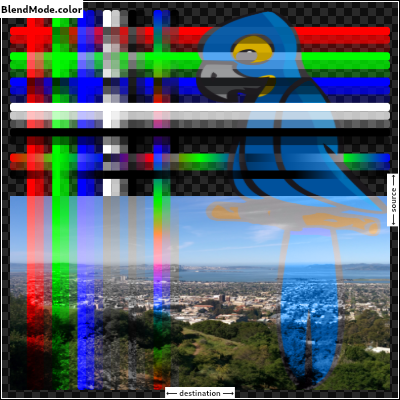 |
| /// |
| /// See also: |
| /// |
| /// * [hue], which is a similar but weaker effect. |
| /// * [softLight], which is a similar tinting effect but also tints white. |
| /// * [saturation], which only applies the saturation of the source image. |
| color, |
| |
| /// Take the luminosity of the source image, and the hue and saturation of the |
| /// destination image. |
| /// |
| /// The opacity of the output image is computed in the same way as for |
| /// [srcOver]. Regions that are entirely transparent in the source image take |
| /// their luminosity from the destination. |
| /// |
| /// 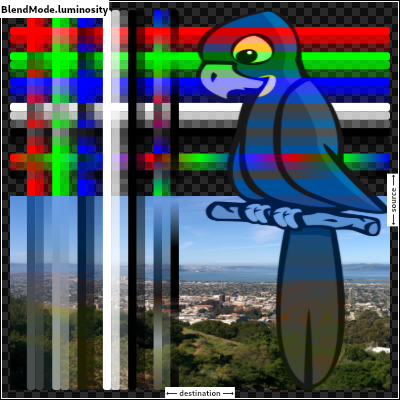 |
| /// |
| /// See also: |
| /// |
| /// * [saturation], which applies the saturation of the source image to the |
| /// destination. |
| /// * [ImageFilter.blur], which can be used with [BackdropFilter] for a |
| /// related effect. |
| luminosity, |
| } |
| |
| /// Different ways to clip a widget's content. |
| enum Clip { |
| /// No clip at all. |
| /// |
| /// This is the default option for most widgets: if the content does not |
| /// overflow the widget boundary, don't pay any performance cost for clipping. |
| /// |
| /// If the content does overflow, please explicitly specify the following |
| /// [Clip] options: |
| /// * [hardEdge], which is the fastest clipping, but with lower fidelity. |
| /// * [antiAlias], which is a little slower than [hardEdge], but with smoothed edges. |
| /// * [antiAliasWithSaveLayer], which is much slower than [antiAlias], and should |
| /// rarely be used. |
| none, |
| |
| /// Clip, but do not apply anti-aliasing. |
| /// |
| /// This mode enables clipping, but curves and non-axis-aligned straight lines will be |
| /// jagged as no effort is made to anti-alias. |
| /// |
| /// Faster than other clipping modes, but slower than [none]. |
| /// |
| /// This is a reasonable choice when clipping is needed, if the container is an axis- |
| /// aligned rectangle or an axis-aligned rounded rectangle with very small corner radii. |
| /// |
| /// See also: |
| /// |
| /// * [antiAlias], which is more reasonable when clipping is needed and the shape is not |
| /// an axis-aligned rectangle. |
| hardEdge, |
| |
| /// Clip with anti-aliasing. |
| /// |
| /// This mode has anti-aliased clipping edges to achieve a smoother look. |
| /// |
| /// It' s much faster than [antiAliasWithSaveLayer], but slower than [hardEdge]. |
| /// |
| /// This will be the common case when dealing with circles and arcs. |
| /// |
| /// Different from [hardEdge] and [antiAliasWithSaveLayer], this clipping may have |
| /// bleeding edge artifacts. |
| /// (See https://fiddle.skia.org/c/21cb4c2b2515996b537f36e7819288ae for an example.) |
| /// |
| /// See also: |
| /// |
| /// * [hardEdge], which is a little faster, but with lower fidelity. |
| /// * [antiAliasWithSaveLayer], which is much slower, but can avoid the |
| /// bleeding edges if there's no other way. |
| /// * [Paint.isAntiAlias], which is the anti-aliasing switch for general draw operations. |
| antiAlias, |
| |
| /// Clip with anti-aliasing and saveLayer immediately following the clip. |
| /// |
| /// This mode not only clips with anti-aliasing, but also allocates an offscreen |
| /// buffer. All subsequent paints are carried out on that buffer before finally |
| /// being clipped and composited back. |
| /// |
| /// This is very slow. It has no bleeding edge artifacts (that [antiAlias] has) |
| /// but it changes the semantics as an offscreen buffer is now introduced. |
| /// (See https://github.com/flutter/flutter/issues/18057#issuecomment-394197336 |
| /// for a difference between paint without saveLayer and paint with saveLayer.) |
| /// |
| /// This will be only rarely needed. One case where you might need this is if |
| /// you have an image overlaid on a very different background color. In these |
| /// cases, consider whether you can avoid overlaying multiple colors in one |
| /// spot (e.g. by having the background color only present where the image is |
| /// absent). If you can, [antiAlias] would be fine and much faster. |
| /// |
| /// See also: |
| /// |
| /// * [antiAlias], which is much faster, and has similar clipping results. |
| antiAliasWithSaveLayer, |
| } |
| |
| /// A description of the style to use when drawing on a [Canvas]. |
| /// |
| /// Most APIs on [Canvas] take a [Paint] object to describe the style |
| /// to use for that operation. |
| abstract class Paint { |
| /// Constructs an empty [Paint] object with all fields initialized to |
| /// their defaults. |
| factory Paint() => |
| engine.experimentalUseSkia ? engine.SkPaint() : engine.SurfacePaint(); |
| |
| /// Whether to dither the output when drawing images. |
| /// |
| /// If false, the default value, dithering will be enabled when the input |
| /// color depth is higher than the output color depth. For example, |
| /// drawing an RGB8 image onto an RGB565 canvas. |
| /// |
| /// This value also controls dithering of [shader]s, which can make |
| /// gradients appear smoother. |
| /// |
| /// Whether or not dithering affects the output is implementation defined. |
| /// Some implementations may choose to ignore this completely, if they're |
| /// unable to control dithering. |
| /// |
| /// To ensure that dithering is consistently enabled for your entire |
| /// application, set this to true before invoking any drawing related code. |
| static bool enableDithering = false; |
| |
| /// A blend mode to apply when a shape is drawn or a layer is composited. |
| /// |
| /// The source colors are from the shape being drawn (e.g. from |
| /// [Canvas.drawPath]) or layer being composited (the graphics that were drawn |
| /// between the [Canvas.saveLayer] and [Canvas.restore] calls), after applying |
| /// the [colorFilter], if any. |
| /// |
| /// The destination colors are from the background onto which the shape or |
| /// layer is being composited. |
| /// |
| /// Defaults to [BlendMode.srcOver]. |
| /// |
| /// See also: |
| /// |
| /// * [Canvas.saveLayer], which uses its [Paint]'s [blendMode] to composite |
| /// the layer when [restore] is called. |
| /// * [BlendMode], which discusses the user of [saveLayer] with [blendMode]. |
| BlendMode get blendMode; |
| set blendMode(BlendMode value); |
| |
| /// Whether to paint inside shapes, the edges of shapes, or both. |
| /// |
| /// If null, defaults to [PaintingStyle.fill]. |
| PaintingStyle get style; |
| set style(PaintingStyle value); |
| |
| /// How wide to make edges drawn when [style] is set to |
| /// [PaintingStyle.stroke] or [PaintingStyle.strokeAndFill]. The |
| /// width is given in logical pixels measured in the direction |
| /// orthogonal to the direction of the path. |
| /// |
| /// The values null and 0.0 correspond to a hairline width. |
| double get strokeWidth; |
| set strokeWidth(double value); |
| |
| /// The kind of finish to place on the end of lines drawn when |
| /// [style] is set to [PaintingStyle.stroke] or |
| /// [PaintingStyle.strokeAndFill]. |
| /// |
| /// If null, defaults to [StrokeCap.butt], i.e. no caps. |
| StrokeCap get strokeCap; |
| set strokeCap(StrokeCap value); |
| |
| /// The kind of finish to use for line segment joins. |
| /// [style] is set to [PaintingStyle.stroke] or |
| /// [PaintingStyle.strokeAndFill]. Only applies to drawPath not drawPoints. |
| /// |
| /// If null, defaults to [StrokeCap.butt], i.e. no caps. |
| StrokeJoin get strokeJoin; |
| set strokeJoin(StrokeJoin value); |
| |
| /// Whether to apply anti-aliasing to lines and images drawn on the |
| /// canvas. |
| /// |
| /// Defaults to true. The value null is treated as false. |
| bool get isAntiAlias; |
| set isAntiAlias(bool value); |
| |
| Color get color; |
| set color(Color value); |
| |
| /// Whether the colors of the image are inverted when drawn. |
| /// |
| /// Inverting the colors of an image applies a new color filter that will |
| /// be composed with any user provided color filters. This is primarily |
| /// used for implementing smart invert on iOS. |
| bool get invertColors; |
| |
| set invertColors(bool value); |
| |
| /// The shader to use when stroking or filling a shape. |
| /// |
| /// When this is null, the [color] is used instead. |
| /// |
| /// See also: |
| /// |
| /// * [Gradient], a shader that paints a color gradient. |
| /// * [ImageShader], a shader that tiles an [Image]. |
| /// * [colorFilter], which overrides [shader]. |
| /// * [color], which is used if [shader] and [colorFilter] are null. |
| Shader get shader; |
| set shader(Shader value); |
| |
| /// A mask filter (for example, a blur) to apply to a shape after it has been |
| /// drawn but before it has been composited into the image. |
| /// |
| /// See [MaskFilter] for details. |
| MaskFilter get maskFilter; |
| set maskFilter(MaskFilter value); |
| |
| /// Controls the performance vs quality trade-off to use when applying |
| /// filters, such as [maskFilter], or when drawing images, as with |
| /// [Canvas.drawImageRect] or [Canvas.drawImageNine]. |
| /// |
| /// Defaults to [FilterQuality.none]. |
| // TODO(ianh): verify that the image drawing methods actually respect this |
| FilterQuality get filterQuality; |
| set filterQuality(FilterQuality value); |
| |
| /// A color filter to apply when a shape is drawn or when a layer is |
| /// composited. |
| /// |
| /// See [ColorFilter] for details. |
| /// |
| /// When a shape is being drawn, [colorFilter] overrides [color] and [shader]. |
| ColorFilter get colorFilter; |
| set colorFilter(ColorFilter value); |
| |
| double get strokeMiterLimit; |
| set strokeMiterLimit(double value); |
| |
| /// The [ImageFilter] to use when drawing raster images. |
| /// |
| /// For example, to blur an image using [Canvas.drawImage], apply an |
| /// [ImageFilter.blur]: |
| /// |
| /// ```dart |
| /// import 'dart:ui' as ui; |
| /// |
| /// ui.Image image; |
| /// |
| /// void paint(Canvas canvas, Size size) { |
| /// canvas.drawImage( |
| /// image, |
| /// Offset.zero, |
| /// Paint()..imageFilter = ui.ImageFilter.blur(sigmaX: .5, sigmaY: .5), |
| /// ); |
| /// } |
| /// ``` |
| /// |
| /// See also: |
| /// |
| /// * [MaskFilter], which is used for drawing geometry. |
| ImageFilter get imageFilter; |
| set imageFilter(ImageFilter value); |
| } |
| |
| /// Base class for objects such as [Gradient] and [ImageShader] which |
| /// correspond to shaders as used by [Paint.shader]. |
| abstract class Shader { |
| /// This class is created by the engine, and should not be instantiated |
| /// or extended directly. |
| Shader._(); |
| } |
| |
| /// A shader (as used by [Paint.shader]) that renders a color gradient. |
| /// |
| /// There are several types of gradients, represented by the various |
| /// constructors on this class. |
| abstract class Gradient extends Shader { |
| /// Creates a linear gradient from `from` to `to`. |
| /// |
| /// If `colorStops` is provided, `colorStops[i]` is a number from 0.0 to 1.0 |
| /// that specifies where `color[i]` begins in the gradient. If `colorStops` is |
| /// not provided, then only two stops, at 0.0 and 1.0, are implied (and |
| /// `color` must therefore only have two entries). |
| /// |
| /// The behavior before `from` and after `to` is described by the `tileMode` |
| /// argument. For details, see the [TileMode] enum. |
| /// |
| ///  |
| /// 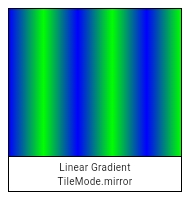 |
| /// 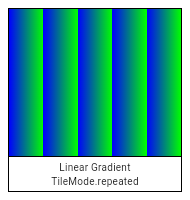 |
| /// |
| /// If `from`, `to`, `colors`, or `tileMode` are null, or if `colors` or |
| /// `colorStops` contain null values, this constructor will throw a |
| /// [NoSuchMethodError]. |
| factory Gradient.linear( |
| Offset from, |
| Offset to, |
| List<Color> colors, [ |
| List<double> colorStops, |
| TileMode tileMode = TileMode.clamp, |
| Float64List matrix4, |
| ]) => |
| engine.GradientLinear(from, to, colors, colorStops, tileMode, matrix4); |
| |
| /// Creates a radial gradient centered at `center` that ends at `radius` |
| /// distance from the center. |
| /// |
| /// If `colorStops` is provided, `colorStops[i]` is a number from 0.0 to 1.0 |
| /// that specifies where `color[i]` begins in the gradient. If `colorStops` is |
| /// not provided, then only two stops, at 0.0 and 1.0, are implied (and |
| /// `color` must therefore only have two entries). |
| /// |
| /// The behavior before and after the radius is described by the `tileMode` |
| /// argument. For details, see the [TileMode] enum. |
| /// |
| /// 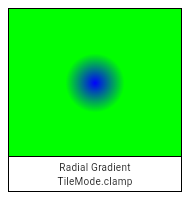 |
| /// 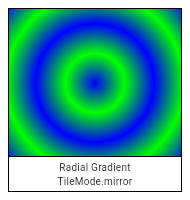 |
| /// 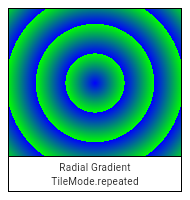 |
| /// |
| /// If `center`, `radius`, `colors`, or `tileMode` are null, or if `colors` or |
| /// `colorStops` contain null values, this constructor will throw a |
| /// [NoSuchMethodError]. |
| /// |
| /// If `matrix4` is provided, the gradient fill will be transformed by the |
| /// specified 4x4 matrix relative to the local coordinate system. `matrix4` |
| /// must be a column-major matrix packed into a list of 16 values. |
| /// |
| /// If `focal` is provided and not equal to `center` and `focalRadius` is |
| /// provided and not equal to 0.0, the generated shader will be a two point |
| /// conical radial gradient, with `focal` being the center of the focal |
| /// circle and `focalRadius` being the radius of that circle. If `focal` is |
| /// provided and not equal to `center`, at least one of the two offsets must |
| /// not be equal to [Offset.zero]. |
| factory Gradient.radial(Offset center, double radius, List<Color> colors, |
| [List<double> colorStops, |
| TileMode tileMode = TileMode.clamp, |
| Float64List matrix4, |
| Offset focal, |
| double focalRadius = 0.0]) { |
| focalRadius ??= 0.0; |
| _validateColorStops(colors, colorStops); |
| // If focal is null or focal radius is null, this should be treated as a regular radial gradient |
| // If focal == center and the focal radius is 0.0, it's still a regular radial gradient |
| final Float32List matrix32 = matrix4 != null ? engine.toMatrix32(matrix4) : null; |
| if (focal == null || (focal == center && focalRadius == 0.0)) { |
| return engine.GradientRadial( |
| center, radius, colors, colorStops, tileMode, matrix32); |
| } else { |
| assert(center != Offset.zero || |
| focal != Offset.zero); // will result in exception(s) in Skia side |
| return engine.GradientConical(focal, focalRadius, center, radius, colors, |
| colorStops, tileMode, matrix32); |
| } |
| } |
| |
| /// Creates a sweep gradient centered at `center` that starts at `startAngle` |
| /// and ends at `endAngle`. |
| /// |
| /// `startAngle` and `endAngle` should be provided in radians, with zero |
| /// radians being the horizontal line to the right of the `center` and with |
| /// positive angles going clockwise around the `center`. |
| /// |
| /// If `colorStops` is provided, `colorStops[i]` is a number from 0.0 to 1.0 |
| /// that specifies where `color[i]` begins in the gradient. If `colorStops` is |
| /// not provided, then only two stops, at 0.0 and 1.0, are implied (and |
| /// `color` must therefore only have two entries). |
| /// |
| /// The behavior before `startAngle` and after `endAngle` is described by the |
| /// `tileMode` argument. For details, see the [TileMode] enum. |
| /// |
| ///  |
| /// 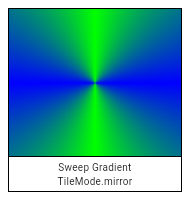 |
| /// 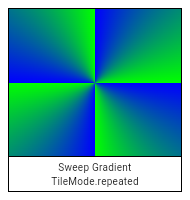 |
| /// |
| /// If `center`, `colors`, `tileMode`, `startAngle`, or `endAngle` are null, |
| /// or if `colors` or `colorStops` contain null values, this constructor will |
| /// throw a [NoSuchMethodError]. |
| /// |
| /// If `matrix4` is provided, the gradient fill will be transformed by the |
| /// specified 4x4 matrix relative to the local coordinate system. `matrix4` |
| /// must be a column-major matrix packed into a list of 16 values. |
| factory Gradient.sweep( |
| Offset center, |
| List<Color> colors, [ |
| List<double> colorStops, |
| TileMode tileMode = TileMode.clamp, |
| double startAngle = 0.0, |
| double endAngle = math.pi * 2, |
| Float64List matrix4, |
| ]) => |
| engine.GradientSweep( |
| center, colors, colorStops, tileMode, startAngle, endAngle, engine.toMatrix32(matrix4)); |
| } |
| |
| /// Opaque handle to raw decoded image data (pixels). |
| /// |
| /// To obtain an [Image] object, use [instantiateImageCodec]. |
| /// |
| /// To draw an [Image], use one of the methods on the [Canvas] class, such as |
| /// [Canvas.drawImage]. |
| abstract class Image { |
| /// The number of image pixels along the image's horizontal axis. |
| int get width; |
| |
| /// The number of image pixels along the image's vertical axis. |
| int get height; |
| |
| /// Converts the [Image] object into a byte array. |
| /// |
| /// The [format] argument specifies the format in which the bytes will be |
| /// returned. |
| /// |
| /// Returns a future that completes with the binary image data or an error |
| /// if encoding fails. |
| Future<ByteData> toByteData( |
| {ImageByteFormat format = ImageByteFormat.rawRgba}); |
| |
| /// Release the resources used by this object. The object is no longer usable |
| /// after this method is called. |
| void dispose(); |
| |
| @override |
| String toString() => '[$width\u00D7$height]'; |
| } |
| |
| /// A description of a color filter to apply when drawing a shape or compositing |
| /// a layer with a particular [Paint]. A color filter is a function that takes |
| /// two colors, and outputs one color. When applied during compositing, it is |
| /// independently applied to each pixel of the layer being drawn before the |
| /// entire layer is merged with the destination. |
| /// |
| /// Instances of this class are used with [Paint.colorFilter] on [Paint] |
| /// objects. |
| abstract class ColorFilter { |
| /// Creates a color filter that applies the blend mode given as the second |
| /// argument. The source color is the one given as the first argument, and the |
| /// destination color is the one from the layer being composited. |
| /// |
| /// The output of this filter is then composited into the background according |
| /// to the [Paint.blendMode], using the output of this filter as the source |
| /// and the background as the destination. |
| const factory ColorFilter.mode(Color color, BlendMode blendMode) = |
| engine.EngineColorFilter.mode; |
| |
| /// Construct a color filter that transforms a color by a 4x5 matrix. |
| /// |
| /// Every pixel's color value, repsented as an `[R, G, B, A]`, is matrix |
| /// multiplied to create a new color: |
| /// |
| /// ``` |
| /// | R' | | a00 a01 a02 a03 a04 | | R | |
| /// | G' | = | a10 a11 a22 a33 a44 | * | G | |
| /// | B' | | a20 a21 a22 a33 a44 | | B | |
| /// | A' | | a30 a31 a22 a33 a44 | | A | |
| /// ``` |
| /// |
| /// The matrix is in row-major order and the translation column is specified |
| /// in unnormalized, 0...255, space. For example, the identity matrix is: |
| /// |
| /// ``` |
| /// const ColorMatrix identity = ColorFilter.matrix(<double>[ |
| /// 1, 0, 0, 0, 0, |
| /// 0, 1, 0, 0, 0, |
| /// 0, 0, 1, 0, 0, |
| /// 0, 0, 0, 1, 0, |
| /// ]); |
| /// ``` |
| /// |
| /// ## Examples |
| /// |
| /// An inversion color matrix: |
| /// |
| /// ``` |
| /// const ColorFilter invert = ColorFilter.matrix(<double>[ |
| /// -1, 0, 0, 0, 255, |
| /// 0, -1, 0, 0, 255, |
| /// 0, 0, -1, 0, 255, |
| /// 0, 0, 0, 1, 0, |
| /// ]); |
| /// ``` |
| /// |
| /// A sepia-toned color matrix (values based on the [Filter Effects Spec](https://www.w3.org/TR/filter-effects-1/#sepiaEquivalent)): |
| /// |
| /// ``` |
| /// const ColorFilter sepia = ColorFilter.matrix(<double>[ |
| /// 0.393, 0.769, 0.189, 0, 0, |
| /// 0.349, 0.686, 0.168, 0, 0, |
| /// 0.272, 0.534, 0.131, 0, 0, |
| /// 0, 0, 0, 1, 0, |
| /// ]); |
| /// ``` |
| /// |
| /// A greyscale color filter (values based on the [Filter Effects Spec](https://www.w3.org/TR/filter-effects-1/#grayscaleEquivalent)): |
| /// |
| /// ``` |
| /// const ColorFilter greyscale = ColorFilter.matrix(<double>[ |
| /// 0.2126, 0.7152, 0.0722, 0, 0, |
| /// 0.2126, 0.7152, 0.0722, 0, 0, |
| /// 0.2126, 0.7152, 0.0722, 0, 0, |
| /// 0, 0, 0, 1, 0, |
| /// ]); |
| /// ``` |
| const factory ColorFilter.matrix(List<double> matrix) = |
| engine.EngineColorFilter.matrix; |
| |
| /// Construct a color filter that applies the sRGB gamma curve to the RGB |
| /// channels. |
| const factory ColorFilter.linearToSrgbGamma() = |
| engine.EngineColorFilter.linearToSrgbGamma; |
| |
| /// Creates a color filter that applies the inverse of the sRGB gamma curve |
| /// to the RGB channels. |
| const factory ColorFilter.srgbToLinearGamma() = |
| engine.EngineColorFilter.srgbToLinearGamma; |
| |
| List<dynamic> webOnlySerializeToCssPaint() { |
| throw UnsupportedError('ColorFilter for CSS paint not yet supported'); |
| } |
| } |
| |
| /// Styles to use for blurs in [MaskFilter] objects. |
| // These enum values must be kept in sync with SkBlurStyle. |
| enum BlurStyle { |
| // These mirror SkBlurStyle and must be kept in sync. |
| |
| /// Fuzzy inside and outside. This is useful for painting shadows that are |
| /// offset from the shape that ostensibly is casting the shadow. |
| normal, |
| |
| /// Solid inside, fuzzy outside. This corresponds to drawing the shape, and |
| /// additionally drawing the blur. This can make objects appear brighter, |
| /// maybe even as if they were fluorescent. |
| solid, |
| |
| /// Nothing inside, fuzzy outside. This is useful for painting shadows for |
| /// partially transparent shapes, when they are painted separately but without |
| /// an offset, so that the shadow doesn't paint below the shape. |
| outer, |
| |
| /// Fuzzy inside, nothing outside. This can make shapes appear to be lit from |
| /// within. |
| inner, |
| } |
| |
| /// A mask filter to apply to shapes as they are painted. A mask filter is a |
| /// function that takes a bitmap of color pixels, and returns another bitmap of |
| /// color pixels. |
| /// |
| /// Instances of this class are used with [Paint.maskFilter] on [Paint] objects. |
| class MaskFilter { |
| /// Creates a mask filter that takes the shape being drawn and blurs it. |
| /// |
| /// This is commonly used to approximate shadows. |
| /// |
| /// The `style` argument controls the kind of effect to draw; see [BlurStyle]. |
| /// |
| /// The `sigma` argument controls the size of the effect. It is the standard |
| /// deviation of the Gaussian blur to apply. The value must be greater than |
| /// zero. The sigma corresponds to very roughly half the radius of the effect |
| /// in pixels. |
| /// |
| /// A blur is an expensive operation and should therefore be used sparingly. |
| /// |
| /// The arguments must not be null. |
| /// |
| /// See also: |
| /// |
| /// * [Canvas.drawShadow], which is a more efficient way to draw shadows. |
| const MaskFilter.blur( |
| this._style, |
| this._sigma, |
| ) : assert(_style != null), |
| assert(_sigma != null); |
| |
| final BlurStyle _style; |
| final double _sigma; |
| |
| /// On the web returns the value of sigma passed to [MaskFilter.blur]. |
| double get webOnlySigma => _sigma; |
| |
| /// On the web returns the value of `style` passed to [MaskFilter.blur]. |
| BlurStyle get webOnlyBlurStyle => _style; |
| |
| @override |
| bool operator ==(dynamic other) { |
| if (other is! MaskFilter) { |
| return false; |
| } |
| final MaskFilter typedOther = other; |
| return _style == typedOther._style && _sigma == typedOther._sigma; |
| } |
| |
| @override |
| int get hashCode => hashValues(_style, _sigma); |
| |
| List<dynamic> webOnlySerializeToCssPaint() { |
| return <dynamic>[_style?.index, _sigma]; |
| } |
| |
| @override |
| String toString() => 'MaskFilter.blur($_style, ${_sigma.toStringAsFixed(1)})'; |
| } |
| |
| /// Quality levels for image filters. |
| /// |
| /// See [Paint.filterQuality]. |
| enum FilterQuality { |
| // This list comes from Skia's SkFilterQuality.h and the values (order) should |
| // be kept in sync. |
| |
| /// Fastest possible filtering, albeit also the lowest quality. |
| /// |
| /// Typically this implies nearest-neighbour filtering. |
| none, |
| |
| /// Better quality than [none], faster than [medium]. |
| /// |
| /// Typically this implies bilinear interpolation. |
| low, |
| |
| /// Better quality than [low], faster than [high]. |
| /// |
| /// Typically this implies a combination of bilinear interpolation and |
| /// pyramidal parametric prefiltering (mipmaps). |
| medium, |
| |
| /// Best possible quality filtering, albeit also the slowest. |
| /// |
| /// Typically this implies bicubic interpolation or better. |
| high, |
| } |
| |
| /// A filter operation to apply to a raster image. |
| /// |
| /// See also: |
| /// |
| /// * [BackdropFilter], a widget that applies [ImageFilter] to its rendering. |
| /// * [SceneBuilder.pushBackdropFilter], which is the low-level API for using |
| /// this class. |
| class ImageFilter { |
| /// Creates an image filter that applies a Gaussian blur. |
| factory ImageFilter.blur({double sigmaX = 0.0, double sigmaY = 0.0}) { |
| if (engine.experimentalUseSkia) { |
| return engine.SkImageFilter.blur(sigmaX: sigmaX, sigmaY: sigmaY); |
| } |
| return engine.EngineImageFilter.blur(sigmaX: sigmaX, sigmaY: sigmaY); |
| } |
| |
| ImageFilter.matrix(Float64List matrix4, |
| {FilterQuality filterQuality = FilterQuality.low}) { |
| // TODO(flutter_web): add implementation. |
| throw UnimplementedError( |
| 'ImageFilter.matrix not implemented for web platform.'); |
| // if (matrix4.length != 16) |
| // throw ArgumentError('"matrix4" must have 16 entries.'); |
| } |
| } |
| |
| /// The format in which image bytes should be returned when using |
| /// [Image.toByteData]. |
| enum ImageByteFormat { |
| /// Raw RGBA format. |
| /// |
| /// Unencoded bytes, in RGBA row-primary form, 8 bits per channel. |
| rawRgba, |
| |
| /// Raw unmodified format. |
| /// |
| /// Unencoded bytes, in the image's existing format. For example, a grayscale |
| /// image may use a single 8-bit channel for each pixel. |
| rawUnmodified, |
| |
| /// PNG format. |
| /// |
| /// A loss-less compression format for images. This format is well suited for |
| /// images with hard edges, such as screenshots or sprites, and images with |
| /// text. Transparency is supported. The PNG format supports images up to |
| /// 2,147,483,647 pixels in either dimension, though in practice available |
| /// memory provides a more immediate limitation on maximum image size. |
| /// |
| /// PNG images normally use the `.png` file extension and the `image/png` MIME |
| /// type. |
| /// |
| /// See also: |
| /// |
| /// * <https://en.wikipedia.org/wiki/Portable_Network_Graphics>, the Wikipedia page on PNG. |
| /// * <https://tools.ietf.org/rfc/rfc2083.txt>, the PNG standard. |
| png, |
| } |
| |
| /// The format of pixel data given to [decodeImageFromPixels]. |
| enum PixelFormat { |
| /// Each pixel is 32 bits, with the highest 8 bits encoding red, the next 8 |
| /// bits encoding green, the next 8 bits encoding blue, and the lowest 8 bits |
| /// encoding alpha. |
| rgba8888, |
| |
| /// Each pixel is 32 bits, with the highest 8 bits encoding blue, the next 8 |
| /// bits encoding green, the next 8 bits encoding red, and the lowest 8 bits |
| /// encoding alpha. |
| bgra8888, |
| } |
| |
| class _ImageInfo { |
| _ImageInfo(this.width, this.height, this.format, this.rowBytes) { |
| rowBytes ??= width * 4; |
| } |
| int width; |
| int height; |
| int format; |
| int rowBytes; |
| } |
| |
| /// Callback signature for [decodeImageFromList]. |
| typedef ImageDecoderCallback = void Function(Image result); |
| |
| /// Information for a single frame of an animation. |
| /// |
| /// To obtain an instance of the [FrameInfo] interface, see |
| /// [Codec.getNextFrame]. |
| abstract class FrameInfo { |
| /// This class is created by the engine, and should not be instantiated |
| /// or extended directly. |
| /// |
| /// To obtain an instance of the [FrameInfo] interface, see |
| /// [Codec.getNextFrame]. |
| FrameInfo._(); |
| |
| /// The duration this frame should be shown. |
| Duration get duration => Duration(milliseconds: _durationMillis); |
| int get _durationMillis => 0; |
| |
| /// The [Image] object for this frame. |
| Image get image => null; |
| } |
| |
| /// A handle to an image codec. |
| class Codec { |
| /// This class is created by the engine, and should not be instantiated |
| /// or extended directly. |
| /// |
| /// To obtain an instance of the [Codec] interface, see |
| /// [instantiateImageCodec]. |
| Codec._(); |
| |
| /// Number of frames in this image. |
| int get frameCount => 0; |
| |
| /// Number of times to repeat the animation. |
| /// |
| /// * 0 when the animation should be played once. |
| /// * -1 for infinity repetitions. |
| int get repetitionCount => 0; |
| |
| /// Fetches the next animation frame. |
| /// |
| /// Wraps back to the first frame after returning the last frame. |
| /// |
| /// The returned future can complete with an error if the decoding has failed. |
| Future<FrameInfo> getNextFrame() { |
| return engine.futurize(_getNextFrame); |
| } |
| |
| /// Returns an error message on failure, null on success. |
| String _getNextFrame(engine.Callback<FrameInfo> callback) => null; |
| |
| /// Release the resources used by this object. The object is no longer usable |
| /// after this method is called. |
| void dispose() {} |
| } |
| |
| /// Instantiates an image codec [Codec] object. |
| /// |
| /// [list] is the binary image data (e.g a PNG or GIF binary data). |
| /// The data can be for either static or animated images. |
| /// |
| /// The following image formats are supported: {@macro flutter.dart:ui.imageFormats} |
| /// |
| /// The returned future can complete with an error if the image decoding has |
| /// failed. |
| Future<Codec> instantiateImageCodec( |
| Uint8List list, { |
| int targetWidth, |
| int targetHeight, |
| }) { |
| return engine.futurize((engine.Callback<Codec> callback) => |
| // TODO: Implement targetWidth and targetHeight support. |
| _instantiateImageCodec(list, callback, null)); |
| } |
| |
| /// Instantiates a [Codec] object for an image binary data. |
| /// |
| /// Returns an error message if the instantiation has failed, null otherwise. |
| String _instantiateImageCodec( |
| Uint8List list, engine.Callback<Codec> callback, _ImageInfo imageInfo) { |
| if (engine.experimentalUseSkia) { |
| if (imageInfo == null) { |
| engine.skiaInstantiateImageCodec(list, callback); |
| } else { |
| engine.skiaInstantiateImageCodec(list, callback, imageInfo.width, |
| imageInfo.height, imageInfo.format, imageInfo.rowBytes); |
| } |
| return null; |
| } |
| final html.Blob blob = html.Blob(<dynamic>[list.buffer]); |
| callback(engine.HtmlBlobCodec(blob)); |
| return null; |
| } |
| |
| Future<Codec> webOnlyInstantiateImageCodecFromUrl(Uri uri, |
| {engine.WebOnlyImageCodecChunkCallback chunkCallback}) { |
| return engine.futurize((engine.Callback<Codec> callback) => |
| _instantiateImageCodecFromUrl(uri, chunkCallback, callback)); |
| } |
| |
| String _instantiateImageCodecFromUrl( |
| Uri uri, |
| engine.WebOnlyImageCodecChunkCallback chunkCallback, |
| engine.Callback<Codec> callback) { |
| callback(engine.HtmlCodec(uri.toString(), chunkCallback: chunkCallback)); |
| return null; |
| } |
| |
| /// Loads a single image frame from a byte array into an [Image] object. |
| /// |
| /// This is a convenience wrapper around [instantiateImageCodec]. |
| /// Prefer using [instantiateImageCodec] which also supports multi frame images. |
| void decodeImageFromList(Uint8List list, ImageDecoderCallback callback) { |
| _decodeImageFromListAsync(list, callback); |
| } |
| |
| Future<void> _decodeImageFromListAsync( |
| Uint8List list, ImageDecoderCallback callback) async { |
| final Codec codec = await instantiateImageCodec(list); |
| final FrameInfo frameInfo = await codec.getNextFrame(); |
| callback(frameInfo.image); |
| } |
| |
| /// Convert an array of pixel values into an [Image] object. |
| /// |
| /// [pixels] is the pixel data in the encoding described by [format]. |
| /// |
| /// [rowBytes] is the number of bytes consumed by each row of pixels in the |
| /// data buffer. If unspecified, it defaults to [width] multipled by the |
| /// number of bytes per pixel in the provided [format]. |
| void decodeImageFromPixels(Uint8List pixels, int width, int height, |
| PixelFormat format, ImageDecoderCallback callback, |
| {int rowBytes}) { |
| final _ImageInfo imageInfo = |
| _ImageInfo(width, height, format.index, rowBytes); |
| final Future<Codec> codecFuture = engine.futurize( |
| (engine.Callback<Codec> callback) => |
| _instantiateImageCodec(pixels, callback, imageInfo)); |
| codecFuture |
| .then((Codec codec) => codec.getNextFrame()) |
| .then((FrameInfo frameInfo) => callback(frameInfo.image)); |
| } |
| |
| /// A single shadow. |
| /// |
| /// Multiple shadows are stacked together in a [TextStyle]. |
| class Shadow { |
| /// Construct a shadow. |
| /// |
| /// The default shadow is a black shadow with zero offset and zero blur. |
| /// Default shadows should be completely covered by the casting element, |
| /// and not be visble. |
| /// |
| /// Transparency should be adjusted through the [color] alpha. |
| /// |
| /// Shadow order matters due to compositing multiple translucent objects not |
| /// being commutative. |
| const Shadow({ |
| this.color = const Color(_kColorDefault), |
| this.offset = Offset.zero, |
| this.blurRadius = 0.0, |
| }) : assert(color != null, 'Text shadow color was null.'), |
| assert(offset != null, 'Text shadow offset was null.'), |
| assert(blurRadius >= 0.0, |
| 'Text shadow blur radius should be non-negative.'); |
| |
| static const int _kColorDefault = 0xFF000000; |
| |
| /// Color that the shadow will be drawn with. |
| /// |
| /// The shadows are shapes composited directly over the base canvas, and do not |
| /// represent optical occlusion. |
| final Color color; |
| |
| /// The displacement of the shadow from the casting element. |
| /// |
| /// Positive x/y offsets will shift the shadow to the right and down, while |
| /// negative offsets shift the shadow to the left and up. The offsets are |
| /// relative to the position of the element that is casting it. |
| final Offset offset; |
| |
| /// The standard deviation of the Gaussian to convolve with the shadow's shape. |
| final double blurRadius; |
| |
| /// Converts a blur radius in pixels to sigmas. |
| /// |
| /// See the sigma argument to [MaskFilter.blur]. |
| /// |
| // See SkBlurMask::ConvertRadiusToSigma(). |
| // <https://github.com/google/skia/blob/bb5b77db51d2e149ee66db284903572a5aac09be/src/effects/SkBlurMask.cpp#L23> |
| static double convertRadiusToSigma(double radius) { |
| return radius * 0.57735 + 0.5; |
| } |
| |
| /// The [blurRadius] in sigmas instead of logical pixels. |
| /// |
| /// See the sigma argument to [MaskFilter.blur]. |
| double get blurSigma => convertRadiusToSigma(blurRadius); |
| |
| /// Create the [Paint] object that corresponds to this shadow description. |
| /// |
| /// The [offset] is not represented in the [Paint] object. |
| /// To honor this as well, the shape should be translated by [offset] before |
| /// being filled using this [Paint]. |
| /// |
| /// This class does not provide a way to disable shadows to avoid inconsistencies |
| /// in shadow blur rendering, primarily as a method of reducing test flakiness. |
| /// [toPaint] should be overriden in subclasses to provide this functionality. |
| Paint toPaint() { |
| return Paint() |
| ..color = color |
| ..maskFilter = MaskFilter.blur(BlurStyle.normal, blurSigma); |
| } |
| |
| /// Returns a new shadow with its [offset] and [blurRadius] scaled by the given |
| /// factor. |
| Shadow scale(double factor) { |
| return Shadow( |
| color: color, |
| offset: offset * factor, |
| blurRadius: blurRadius * factor, |
| ); |
| } |
| |
| /// Linearly interpolate between two shadows. |
| /// |
| /// If either shadow is null, this function linearly interpolates from a |
| /// a shadow that matches the other shadow in color but has a zero |
| /// offset and a zero blurRadius. |
| /// |
| /// {@template dart.ui.shadow.lerp} |
| /// The `t` argument represents position on the timeline, with 0.0 meaning |
| /// that the interpolation has not started, returning `a` (or something |
| /// equivalent to `a`), 1.0 meaning that the interpolation has finished, |
| /// returning `b` (or something equivalent to `b`), and values in between |
| /// meaning that the interpolation is at the relevant point on the timeline |
| /// between `a` and `b`. The interpolation can be extrapolated beyond 0.0 and |
| /// 1.0, so negative values and values greater than 1.0 are valid (and can |
| /// easily be generated by curves such as [Curves.elasticInOut]). |
| /// |
| /// Values for `t` are usually obtained from an [Animation<double>], such as |
| /// an [AnimationController]. |
| /// {@endtemplate} |
| static Shadow lerp(Shadow a, Shadow b, double t) { |
| assert(t != null); |
| if (a == null && b == null) { |
| return null; |
| } |
| if (a == null) { |
| return b.scale(t); |
| } |
| if (b == null) { |
| return a.scale(1.0 - t); |
| } |
| return Shadow( |
| color: Color.lerp(a.color, b.color, t), |
| offset: Offset.lerp(a.offset, b.offset, t), |
| blurRadius: lerpDouble(a.blurRadius, b.blurRadius, t), |
| ); |
| } |
| |
| /// Linearly interpolate between two lists of shadows. |
| /// |
| /// If the lists differ in length, excess items are lerped with null. |
| /// |
| /// {@macro dart.ui.shadow.lerp} |
| static List<Shadow> lerpList(List<Shadow> a, List<Shadow> b, double t) { |
| assert(t != null); |
| if (a == null && b == null) { |
| return null; |
| } |
| a ??= <Shadow>[]; |
| b ??= <Shadow>[]; |
| final List<Shadow> result = <Shadow>[]; |
| final int commonLength = math.min(a.length, b.length); |
| for (int i = 0; i < commonLength; i += 1) |
| result.add(Shadow.lerp(a[i], b[i], t)); |
| for (int i = commonLength; i < a.length; i += 1) |
| result.add(a[i].scale(1.0 - t)); |
| for (int i = commonLength; i < b.length; i += 1) { |
| result.add(b[i].scale(t)); |
| } |
| return result; |
| } |
| |
| @override |
| bool operator ==(dynamic other) { |
| if (identical(this, other)) { |
| return true; |
| } |
| if (other is! Shadow) { |
| return false; |
| } |
| final Shadow typedOther = other; |
| return color == typedOther.color && |
| offset == typedOther.offset && |
| blurRadius == typedOther.blurRadius; |
| } |
| |
| @override |
| int get hashCode => hashValues(color, offset, blurRadius); |
| |
| @override |
| String toString() => 'TextShadow($color, $offset, $blurRadius)'; |
| } |
| |
| |
| /// A shader (as used by [Paint.shader]) that tiles an image. |
| class ImageShader extends Shader { |
| /// Creates an image-tiling shader. The first argument specifies the image to |
| /// tile. The second and third arguments specify the [TileMode] for the x |
| /// direction and y direction respectively. The fourth argument gives the |
| /// matrix to apply to the effect. All the arguments are required and must not |
| /// be null. |
| factory ImageShader( |
| Image image, |
| TileMode tmx, |
| TileMode tmy, |
| Float64List matrix4) { |
| if (engine.experimentalUseSkia) { |
| return engine.EngineImageShader(image, tmx, tmy, matrix4); |
| } |
| throw UnsupportedError( |
| 'ImageShader not implemented for web platform.'); |
| } |
| } |